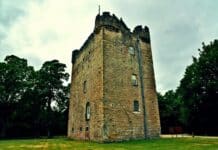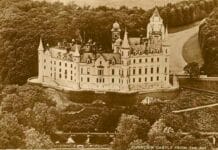Edinburgh is well known as a place of mirk, hauntings and other nasties, to the extent that it has produced a profitable cottage industry of dark tourism. MJ STEEL COLLINS has delved even further into the Scottish capital’s nefarious past to dig up even more grim Edinburgh facts…
1. In 1645, the final and most deadly of all the plagues to strike Edinburgh hit. The Scottish Parliament upped sticks to the safer environs of Stirling, whilst over half the population of Leith perished. Things were so bad, a grim rule was enacted, stating that any parent concealing a child with the Plague would be executed either by hanging or drowning in the Nor’ Loch.
2. The Nor’ Loch was artificially created in 1460 when James III ordered the ground to be flooded to improve Edinburgh Castle’s defences. The Nor’ Loch was nothing more than the city’s cesspool. If it was noxious and minging, it no doubt made its way to the Loch, including the raw sewage that flowed down the steep streets after being poured out chamber pots from bedroom windows, with a cry of “Gardyloo!” to warn passers by below. Corpses also made up part of the effluvia floating round the Nor’ Loch, which was a popular site for suicides. The Loch was filled in and turned into the pleasant Princes Street Gardens during the building of The New Town.
3. The various underground streets and vaults in Edinburgh are renowned for their various hauntings and horrendous living conditions. A surprising figure said to have been born in the vaults is none other than William McGonagall, best known as the writer of the worst poetic works in the English language.
4. Maggie Dickson was a former fish hawker, who wound up working for an inn keeper in either Edinburgh or Musselburgh after the disappearance of her husband. She fell pregnant after an affair with the inn keeper’s son, a fact which Maggie tried to hide. When her child was found dead (it’s not known if the baby was stillborn or murdered), Maggie was charged under the Concealment of Pregnancy Act, which saw her hanged at the Grassmarket on the 2nd of September 1724. However, the hanging was botched, and while her funeral cortege stopped for a whisky, it was discovered that Maggie was still alive in her coffin. Under Scots Law, she had already served her sentence, so couldn’t hanged again for her crime. She was also legally dead! Maggie returned to her old job as a fish hawker round Edinburgh, living a long life, and known to locals as Hauf Hangit Maggie.
5. Located in the Royal Mile, just outside St Giles Kirk, the Heart of Midlothian marks the site of the former Edinburgh Tolbooth, the former city prison. It was here that John Porteous, Captain of the Guard, was removed from his cell and lynched by an incensed Edinburgh mob in 1736. Porteous had been charged with murder and faced the death penalty, but this had been commuted thanks to Porteous’ connections with certain people in authority. During a riot, following the hanging of a smuggler named Andrew Wilson, Porteous ordered his men to fire into the crowd, killing somewhere in the region of between six to nine men. As the man who gave the order to fire, he was the one to face the rap. The public weren’t happy that Porteous had dodged the noose, so took matters into their own hands by storming the Tolbooth, removing Porteous from his cell and hanging him themselves from a dyer’s pole with a rope taken from a draper’s shop. Thoughtfully, the mob left the draper payment for the rope.
6. In Edinburgh, parking is notoriously difficult, to the point that you might find yourself parking on famous historical personage. John Knox was a key figure in the Scottish Reformation, who was laid to rest in St Giles’ graveyard. In the 19th century, the graveyard was cleared out, the remains covered in lime and dumped in Greyfriars Kirkyard. The former St Giles graveyard is now a car park, and in Bay 23, a plaque marks what is believed to be John Knox’s final resting place.
7. John Polidori was one of those who took part in that famous horror story contest held between Lord Byron, Percy Shelley and Mary Shelley, which produced Mary Shelley’s Frankenstein. Polidori’s own offering was the short tale, The Vampyre, said to have been an influence on Dracula. Polidori had been a medical student in Edinburgh at the height of the bodysnatching days, which were said to have influenced his story.
8. Covenanter’s Prison in Greyfriars Kirkyard is perhaps best known for the curmudgeonly Mackenzie Poltergeist, which regularly takes a swipe at tourists visiting its lair. The Prison itself was the site of what is said to be the world’s first concentration camp. Following the Battle of Bothwell Bridge in 1679, the Lord Advocate Sir George Mackenzie had several hundred of the defeated Covenanters locked up in the open air in this section of the Kirkyard, left to suffer disease and the harsh winter elements. Most died, and some sent into slavery, the ship they were carried in sinking not long after setting off. The bodies of those who died are still said to lie within the confines of the prison, buried where they perished.
9. Staying at Greyfriar’s Kirkyard, the land in which it is located was originally a valley. So many corpses have been buried there over the centuries, that it is now an artificial hill of dead bodies, with a thin topsoil, from which bones still pop out of.
10. The poet T S Elliot once had a flat overlooking Greyfriar’s Kirkyard, and often saw cats appearing at his window, which he wound up naming. This inspired his book Old Possum’s Book Of Practical Cats, which later became the inspiration for none other than the smash hit musical Cats!
11. A massive street fight that took place in 1520 between 500 men of the Hamilton and Douglas families, in which 80 died. became known as the Cleansing of the Causeway after the river of blood that is said to have flowed down the High Street afterwards.
12. It is well known that Dickens is said to have got the inspiration for Ebeneezer Scrooge of A Christmas Carol after misreading the name of Ebeneezer Scroggie, in the Canongate Kirkyard. The real Ebeenezer Scroggie, who died in 1836, is said to have been the exact opposite of his fictional miserly counterpart. A meal merchant, Scroggie was something of a good time boy, who enjoyed partying and got a servant girl pregnant after a night of passion on top of a grave.
13. The Edinburgh Mob was notoriously an unforgiving one, not afraid to make their opinion known of those they didn’t like. Such was the case in 1732 at the funeral of Col. Francis Charteris, a man so bad, he was drummed out of the army several times for accepting bribes and sexual assault and served as the inspiration for both Cleland’s Fanny Hill and Hogarth’s A Rake’s Progress. The Edinburgh Mob advanced on the funeral procession and paid their respects by throwing dead cats into Charteris’s freshly dug grave.








I saw the Ebenezer grave! 🙂